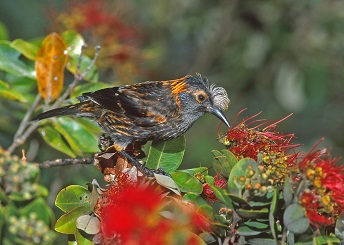Last updated: April 10, 2020
Lesson Plan
Create A Habitat

- Grade Level:
- Lower Elementary: Pre-Kindergarten through Second Grade
- Subject:
- Science
- Lesson Duration:
- 60 Minutes
- State Standards:
- Hawai‘i Content and Performance Standards III:
SC.2.5.1 Identify distinct environments and the different kinds of organisms each environment supports. - Additional Standards:
- Next Generation Science Standards:
K-ESS3-1, 2-LS2-2 - Thinking Skills:
- Understanding: Understand the main idea of material heard, viewed, or read. Interpret or summarize the ideas in own words. Applying: Apply an abstract idea in a concrete situation to solve a problem or relate it to a prior experience. Analyzing: Break down a concept or idea into parts and show the relationships among the parts. Creating: Bring together parts (elements, compounds) of knowledge to form a whole and build relationships for NEW situations.
Essential Question
What is the best habitat for native species?
What do species need to thrive in a habitat?
Can these species live anywhere in the world? Why or why not?
Objective
At the end of this lesson, the students will be able to:
1. Demonstrate an understanding that a habitat is a home, and native habitats are the best and only home for native species.
2. Recognize that some plants and animals have specific needs and live in special homes that give them what they need.
Background
There are many plants and animals that will share the same habitat. The animals and plants that live together in a habitat form a community. There are many different habitats in Haleakalā National Park. Some of the habitats are: alpine desert, subalpine shrub land, cloud forest, tropical rain forest, freshwater, and coastal. Because resources like food and water may be limited, plant and animal species often compete with each other for these resources.
The only way that they can all live together is if they each occupy slightly different niches or hold different "jobs" in the habitat. No two species can occupy exactly the same niches. Often the species jobs are helpful to other species in the same habitat. Every habitat contains a variety of different elements that together help meet the survival needs of its residents.
Preparation
Materials Needed:
Create a Habitat Diorama parent letter to distribute to children
Shoebox
Construction paper
Various supplies based on your habitat (For example: Play dough in various colors, sand, some leaves from the yard, cotton balls to use as snow or clouds etc.)
Materials
Create A Habitat Diorama parent letter with instructions and example images
Download Create A Habitat Diorama parent letter
Procedure
Step 1: Review habitats
- Ask the students to tell you about the different habitats they have learned about.
- Remind them of the many habitats found in Haleakalā National Park like the alpine desert, subalpine shrub land, cloud forest, tropical rain forest, freshwater streams, and coastal habitats.
- What sorts of things might we find in a habitat? = sources of food, water, shelter, space, and other creatures.
Step 2: Select a habitat
- Ask the children to select a habitat found in Haleakalā National Park for them to model.
- On a piece of paper, brainstorm with the children what the scenery might look like in their habitat (trees, mountains, streams).
- What types of plants and animals live in that particular habitat?
- What do they use for food, shelter, and where might they find water?
- They can draw a sketch of what they want their habitat to look like to use as a guide.
Step 3: Assign diorama homework project
- Tell the students that they will work at home with their parents to create a habitat inside a shoebox.
- This is called a diorama and it is a miniature model of a real habitat.
- Pass out the Create a Habitat Diorama parent letter.
- They will bring the completed diorama habitat back to school to present to their classmates.
Vocabulary
Habitat: A home where an animal or plant finds food, water, shelter and space to survive.
Niche: A species’ job.
